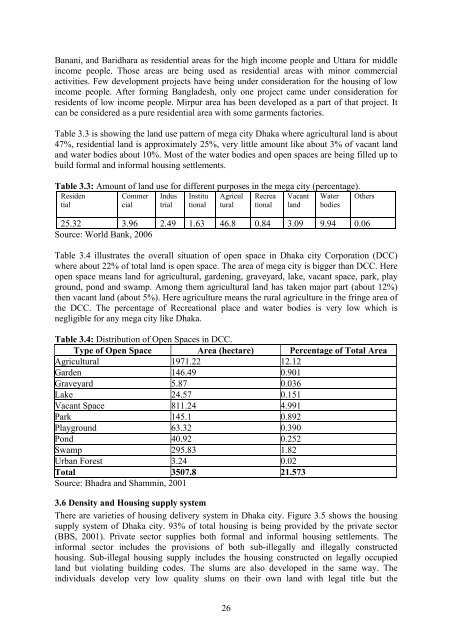Physical Density and Urban Sprawl: A Case of Dhaka City - KTH
Physical Density and Urban Sprawl: A Case of Dhaka City - KTH
Physical Density and Urban Sprawl: A Case of Dhaka City - KTH
You also want an ePaper? Increase the reach of your titles
YUMPU automatically turns print PDFs into web optimized ePapers that Google loves.
Banani, <strong>and</strong> Baridhara as residential areas for the high income people <strong>and</strong> Uttara for middle<br />
income people. Those areas are being used as residential areas with minor commercial<br />
activities. Few development projects have being under consideration for the housing <strong>of</strong> low<br />
income people. After forming Bangladesh, only one project came under consideration for<br />
residents <strong>of</strong> low income people. Mirpur area has been developed as a part <strong>of</strong> that project. It<br />
can be considered as a pure residential area with some garments factories.<br />
Table 3.3 is showing the l<strong>and</strong> use pattern <strong>of</strong> mega city <strong>Dhaka</strong> where agricultural l<strong>and</strong> is about<br />
47%, residential l<strong>and</strong> is approximately 25%, very little amount like about 3% <strong>of</strong> vacant l<strong>and</strong><br />
<strong>and</strong> water bodies about 10%. Most <strong>of</strong> the water bodies <strong>and</strong> open spaces are being filled up to<br />
build formal <strong>and</strong> informal housing settlements.<br />
Table 3.3: Amount <strong>of</strong> l<strong>and</strong> use for different purposes in the mega city (percentage).<br />
Residen Commer Indus Institu Agricul Recrea Vacant Water Others<br />
tial<br />
cial trial tional tural tional l<strong>and</strong> bodies<br />
25.32 3.96 2.49 1.63 46.8 0.84 3.09 9.94 0.06<br />
Source: World Bank, 2006<br />
Table 3.4 illustrates the overall situation <strong>of</strong> open space in <strong>Dhaka</strong> city Corporation (DCC)<br />
where about 22% <strong>of</strong> total l<strong>and</strong> is open space. The area <strong>of</strong> mega city is bigger than DCC. Here<br />
open space means l<strong>and</strong> for agricultural, gardening, graveyard, lake, vacant space, park, play<br />
ground, pond <strong>and</strong> swamp. Among them agricultural l<strong>and</strong> has taken major part (about 12%)<br />
then vacant l<strong>and</strong> (about 5%). Here agriculture means the rural agriculture in the fringe area <strong>of</strong><br />
the DCC. The percentage <strong>of</strong> Recreational place <strong>and</strong> water bodies is very low which is<br />
negligible for any mega city like <strong>Dhaka</strong>.<br />
Table 3.4: Distribution <strong>of</strong> Open Spaces in DCC.<br />
Type <strong>of</strong> Open Space Area (hectare) Percentage <strong>of</strong> Total Area<br />
Agricultural 1971.22 12.12<br />
Garden 146.49 0.901<br />
Graveyard 5.87 0.036<br />
Lake 24.57 0.151<br />
Vacant Space 811.24 4.991<br />
Park 145.1 0.892<br />
Playground 63.32 0.390<br />
Pond 40.92 0.252<br />
Swamp 295.83 1.82<br />
<strong>Urban</strong> Forest 3.24 0.02<br />
Total 3507.8 21.573<br />
Source: Bhadra <strong>and</strong> Shammin, 2001<br />
3.6 <strong>Density</strong> <strong>and</strong> Housing supply system<br />
There are varieties <strong>of</strong> housing delivery system in <strong>Dhaka</strong> city. Figure 3.5 shows the housing<br />
supply system <strong>of</strong> <strong>Dhaka</strong> city. 93% <strong>of</strong> total housing is being provided by the private sector<br />
(BBS, 2001). Private sector supplies both formal <strong>and</strong> informal housing settlements. The<br />
informal sector includes the provisions <strong>of</strong> both sub-illegally <strong>and</strong> illegally constructed<br />
housing. Sub-illegal housing supply includes the housing constructed on legally occupied<br />
l<strong>and</strong> but violating building codes. The slums are also developed in the same way. The<br />
individuals develop very low quality slums on their own l<strong>and</strong> with legal title but the<br />
26

















